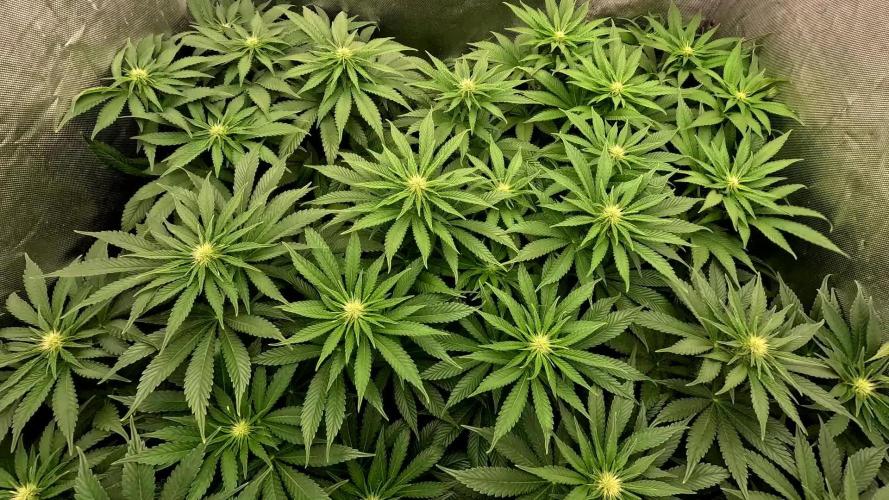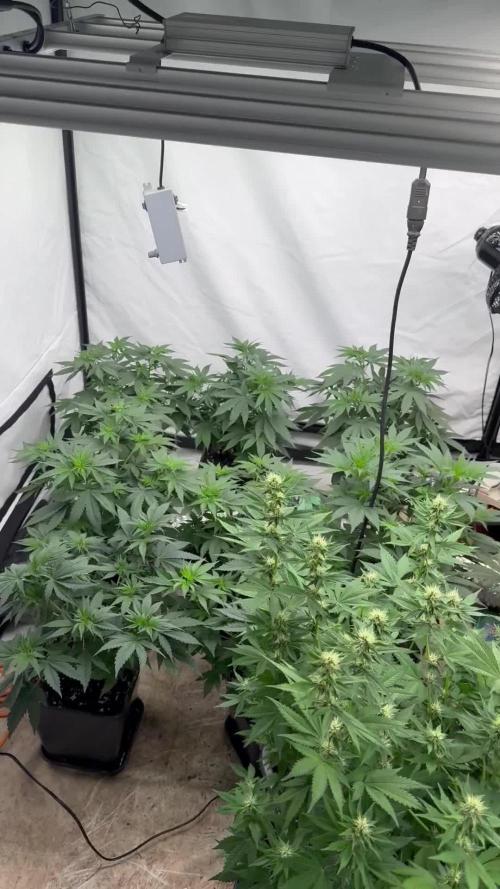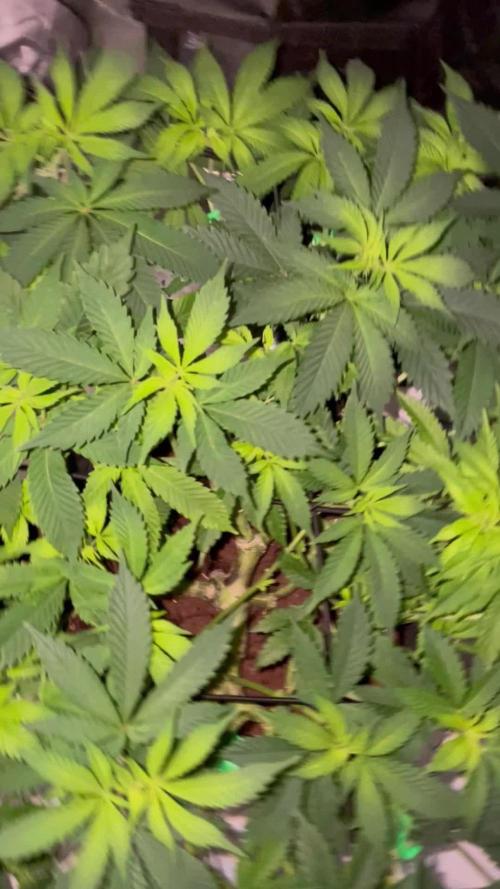The Grow Awards 2026 🏆 



























Likes
Comments
Share


@Qutro
Follow
Hi there fellow cultivators,
Here we go with flowering week 9 in our garden of chill. This week the focus was on let the girls shine and show off their lovely colours.
They were able to give the most beautiful experience in this mature phase in terms of appearance.🍁🌱
I feel lucky every day when I open the tent and marvel at one of nature's most beautiful creature.🙏💚 I will miss growing in the next few months very bad.
This week just watered with PH-d de chlorinated tap water.
Day 60:
One lady is going in to a darkness with the Shogun warrior.
Flowering Day 62:
This Girls are pretty much ready to harvest, i am letting them mature for a few days and in to 48 hours dark before harvest. On day 65 i am gonna make the chop chop.⚔️
The smell is very strong in the whole house if I open the tent even a little.😎
Is completely unreal and I am so very excited to sample each pheno.
See you in a while with the harvest report!
Peace 🏻
Likes
119
Share


@DogDoctorOfficial
Follow
I love growing and i love the GD community, we are like a big canna family and its a pleasure and an honor to be part of this all. Thank you all for being here , for growing and believing in this beautiful healing plant . Growers love to you all
Likes
Comments
Share


@gr3g4l
Follow
Una semanita más y ya preparadas para el engorde. Tallos duros, no mucha distancia intermodal y de hoja relativamente anchita
A principio de la semana una poda de bajos, ramas y hojas.
A los 26 dias me di cuenta que hice corto de espacio y posiblemente me sobre una de ellas.
Processing
Likes
15
Share


@MG2009
Follow
09/26/2020
She is almost done, I gave her a little trim most trichomes are milky still some clear I think about a week before she is done.
Hope she gets fat!
Likes
11
Share


@Fleetwood
Follow
I love the buds, short and stocky. Covered in crystals, plant didnt get any aphids, and the other 3 growing in the same tent did.
Likes
17
Share


@420DeepGrow
Follow
Gracias al equipo de Seedsman Marshydro XpertNutrients y Trolmaster sin ellos esto no sería posible.
💐🍁 Tangerine Snow F1 Fast:
Esta gran cepa es un cruce de cuatro vías 75% sativa de (Boost x Tangelo) con (Lavender x Power Plant). Este híbrido Fast F1 proviene de la genética Cali y cuenta con excelentes terpenos cítricos, alta producción de resina para extractos, altos niveles de THC, muy buenos rendimientos y excelente resistencia al moho. Tangerine Snow F1 Fast se puede cultivar tanto en interior como en exterior. Los tiempos de floración en interiores son de entre 8 y 10 semanas, mientras que el tiempo de cosecha en las latitudes del norte es en septiembre, mientras que en el hemisferio sur los productores cosecharán durante marzo. Las regiones climáticas recomendadas son cálidas, secas, húmedas y cálidas. Se trata de plantas altas, semiramificadas, que superan los 200cm y que presentan un alto vigor con muy buena uniformidad. Al igual que muchas otras variedades con fuerte dominancia sativa, Tangerine Snow F1 Fast ofrece una excelente resistencia al moho, así como a las plagas y enfermedades de las plantas. La combinación de terpenos cítricos y mucha resina la convierten en una cepa de muy buen extracto, cuyo método de "lavado" produce muy buenos rendimientos de hachís. El perfil de terpenos cítricos recuerda a las mandarinas y mandarinas y también tiene notas dulces. La producción de THC ha sido verificada en laboratorio en un fuerte 24%, mientras que el CBD es bajo. El efecto es edificante y energizante, perfecto para usar durante el día y las primeras horas de la noche.
🌻🚀 Consigue aqui tus semillas:
💡TS-3000 + TS-1000: se usaran dos de las lámparas de la serie TS de Marshydro, para cubrir todas las necesidades de las plantas durante el ciclo de cultivo, uso las dos lámparas en floracion para llegar a toda la carpa de 1.50 x 1.50 x 1.80.
https://marshydro.eu/products/mars-hydro-ts-3000-led-grow-light/
🏠 : Marshydro 1.50 x 1.50 x 1.80, carpa 100% estanca con ventanas laterales para llegar a todos los lugares durante el grow
https://marshydro.eu/products/diy-150x150x200cm-grow-tent-kit
🌬️💨 Marshydro 6inch + filtro carbon para evitar olores indeseables.
https://marshydro.eu/products/ifresh-smart-6inch-filter-kits/
💻 Trolmaster Tent-X TCS-1 como controlador de luz, optimiza tu cultivo con la última tecnología del mercado, desde donde puedes controlar todos los parametros.
https://www.trolmaster.com/Products/Details/TCS-1
🍣🍦🌴 Xpert Nutrients es una empresa especializada en la producción y comercialización de fertilizantes líquidos y tierras, que garantizan excelentes cosechas y un crecimiento activo para sus plantas durante todas las fases de cultivo.
Consigue aqui tus Nutrientes:
https://xpertnutrients.com/es/shop/
📆 Semana 9:
No ha sido una gran semana respecto al tiempo pero el incremento de nutrientes le ha venido muy bien
Continuo con la dosis recomendada por el fabricante.
Likes
8
Share


@DankStank
Follow
Sour diesel and northern lights are ready to be chopped. I will put them in the basement in the dark for at least a day before I cut them down. The clone from the expert haze had to be tossed because I found spider mites on it and then found them on my expert haze plant outdoors. I shouldn’t have brought the clone inside, oops I will not be making another clone of this plant. I have found caterpillars all over everything and didn’t want to spray the buds with pesticides so every day a couple of times a day I would remove them. They eat a lot so I don’t have as much production at harvest. I will be more aggressive with the expert haze with pest control.
Likes
1
Share


@Abracadabra69
Follow
Been all good this week , starting to stack after the stretch 😎👍🏽
Moved in 8 more from other tent to also put into flower
Likes
3
Share


@RunicKevin58675
Follow
Good morning to all growers!! This has been another rewarding week for my eyes but the real satisfaction has yet to begin especially for my nome ;D! The plants are getting very large, the one with the bucket pot has responded very well, the one with the cardboard a little too well and is towering over the others, although the LST is struggling to keep it at bay... While the one with the tissue pot has answered a little badly but he is recovering slowly
Likes
17
Share


@Susquihanna
Follow
This week my FB 2025 grew 2 inches taller. it was a very rainy week this week so I did not feed any nutrients to my plant. My plant was too wet from all of the rain. I just let nature do its thing.
Likes
37
Share


@Chunkmasta1
Follow
Well she’s is strong and today is day one of flower. I have turned the lights off for the next 24 hours. Cleaned the Reservoir. Increased the nutrients for the flip. I am running 1 mL of each flora grow flora bloom flora micro silica and Cal mag. My 12 hour light schedule be from 8 AM to 8 PM lights on 8 PM to 8 AM lights off. I will need to dehumidify a little bit to get it down to about 50 and then 45 I believe would be good once the pistols start coming in and colas start to grow. Ive been thru a lot with this plant due to user error but the genetics are strong and this plant can take serious abuse. I would absolutely recommend the strain for a beginner as you can see my many mess ups and still this plant survived and is ready to be budded now. She scroged well with topping multiple times. She’s not a fan of heavy nutrients she also does not like a high pH. You can clearly see the bomb genetics in it as these plants tend to explode in growth very easily. I am extremely happy with this growth so far even with the hiccups. I cannot wait to see these callers grow hopefully fat and happy and heavy.
Likes
8
Share


@Mahali
Follow
Going into flower on 4/10. Plants have been growing and inch or two every day. Suspect front middle and back middle to be males.
Likes
Comments
Share


@Kardo
Follow
Sie hat sich den Platz genommen den sie braucht jetzt ist Zeit für die Blüte mal schauen wie sie in 5 Wochen aussieht.
Bis jetzt bin ich super zufrieden sie ist buschig und hat eine schöne Farbe ich bin gespannt wie die buds aussehen werden 😁
Processing
Likes
59
Share


@Ganjagrandaddy
Follow
Day 16: What a good week for these girls. They initially looked like slow starters but soon have picked their pace up and now appear the biggest group of the strains growing as a whole. They are nice and green looking throughout and it looks like the LOS may be the leader so far.
I am stoked with the strains
I have running now and their speed is phenomenal. Seeing how quickly they have all changed in such a short time gives me a lot of confidence for their finish. Bring it on fast buds. Your impressing the hell out of me

































